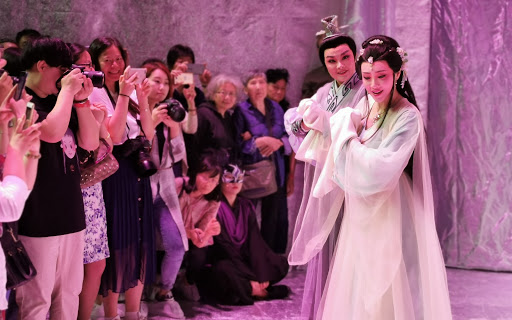Bridging The Gaps
Mixed Reality Performance of Chinese Opera in Rural and Urban Shanghai
Bridging the Gaps is funded by the UK Arts and Humanities Research Council (AHRC) through its UK-China research-industry creative partnership grant, with matched funding and in-kind contribution from UK and Chinese industry partners totalling over £1.5m.
Taking Chinese opera as a case study, the project brings together arts institutions, digital media SMEs and government policy makers from both countries, to assist in-depth understanding of transnational production and consumption patterns. It provides a rare and exciting opportunity for UK arts institutions, government bodies and SMEs to enter the Chinese market as a cluster, with complementary areas of expertise. This will provide both countries with linguistic and cultural support and shared resource, whilst also developing partnerships in Shanghai and establishing a long-term ‘creative chain’.
Shanghai is separated into Pudong and Puxi: the former originally comprising of underdeveloped rural countryside; the latter occupying affluent economic and cultural quarters built by former British, French and other foreign concessions. Whilst Western imported modern drama has been established since the early 20th century in Shanghai Puxi, as the symbol of Shanghai’s young middle class and represented by Shanghai Dramatic Arts Centre, Chinese opera, a form of popular culture, predominantly relating to rural communities and rural migrant workers in urban cities, carries low social and cultural capital and struggles to engage with the young urban audience.
By 2016, China emerged as the second largest economy in the world. Chinese opera has been fused with tourism for regional economic development and global soft power insertion, exemplified in 2017 by the £100 million investment in building an opera village, which includes a digital technology opera museum at Shanghai Pudong Chuansha village. All five Shanghai Opera Houses (Kun Opera, Beijing Opera, All-female Yue Opera, Hu Opera, Huai Opera), whose offices are situated in Puxi’s former French concession area, receive increasing government subsidies for productions and new theatre complexes. However, both the Opera Village in Pudong and Opera Houses in Puxi continue to struggle to engage the young urban audience. Shanghai Dramatic Arts Centre is China’s largest modern drama theatre outside Beijing. It is also located in Puxi but has never collaborated with any of the opera houses. The gaps in Shanghai between urban and rural, modern and traditional may be subtle, but thorough.
The Bridging the Gaps project specifically adopts Shanghai Yueju as a case study. The project brings together a cluster of UK-China research-industry partners with complementary skills, to explore the potential of mixed reality performance in bridging Shanghai’s rural and urban communities and developing respective creative economies across China and the UK. This project is primarily ‘action-research’. As such, the development of the project will be highly iterative, with the research team working closely with industry partners in a reflective and participatory manner, whilst exploring answers to the concept and practice of building a sustainable ‘creative chain’ amongst SMEs, art institutions and policy makers in the process of global production and consumption.
Project contact
Partners
| Partner name |
| Leeds City Council: Museums and Galleries |
| Shanghai Textile Museum |
| Dubit |
| Stage@Leeds |







